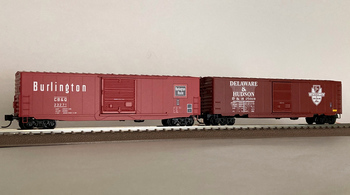Improvements in the Past Decade [Column_Parts & Materials]
 : MTL products with the new frame (left) and the old frame (right)
: MTL products with the new frame (left) and the old frame (right)The lowering of the underframe achieved by Micro-Trains Line is thought to be one of the most significant product improvements made by N scale model manufacturers in the past decade.
High-riding body and truck-mounted couplers featured on MTL N scale boxcars were long discussed among serious modelers. MTL finally introduced its #180 to #182 series boxcars in July 2017. But MTL only boasted of its etched metal brake platforms at that time. At last, in January 2019, MTL announced its “New Lowered Underframe w/Body-Mount Couplers” resolving the discussion.
The improvement is obvious in my photos represented here. CB&Q 23271 has the new underframe, and D&H 25019 has the traditional underframe. Both have genuine trucks. Compared to the old product, the floor of the new product is definitely lowered. But the extreme height seems the same between the two. Accordingly, the side of the new body looks much “great”.
How did they do that? Photos below clearly show the solution: simply lowering the height of the bolster and thinning the floor to avoid contact with the wheels. Thus, the new underframe also fits the old body. But the traditional MTL trucks with couplers won’t fit the new underframe: the coupler box conflicts with the frame. So, if you decided to swap your old underframe, you also have to swap trucks and couplers. Moreover, if you do so, the car will become a "little boy".
As I mentioned above, the couplers of MTL #180 to #182 series boxcars are Body-mounted. The body-mount longer shank couplers are adopted to these cars, maybe due to negotiating tight curves and turnouts. But, it causes more distance coupling than traditional coupling made by truck-mount shorter shank couplers.
Then, what is the purpose of the body-mounting of the couplers in N scale? One says it's much smoother when backing a train through the turnouts. One says it’s more realistic. These don’t affect me for the time being: I don’t switch, I don’t need details like train lines or cut levers on my boxcars, and I prefer space-efficient close coupling.
The improvement done by MTL shows continuity: replaceable but even overall. Though, I won’t swap my old underframes concerning the sense of unity of the extreme height. The only anxiety I have is the mixture use of truck-mount couplers and body-mount couplers.
メーカーによる製品の改良についての話題である。この10年の間でも、Nスケールのボックスカーでは、金属車輪の導入や屋根歩み板の細密化、扉の作り分けなど多くの改良がなされてきた。筆者が特に注目したのはMTLによる「Lowered Underframe」の導入である。
以前から、MTL製ボックスカーの腰の高さと連結器の台車取り付けについては、SNSなどでよく指摘されてきた。また、それを自分で改良する手法も幾件か示されてきた。それだけに、メーカー自身がどのような改良方法を提示したのか、気になっていた。今回、件の改良製品を入手したので、詳しく見てみる。
従来製品と並べて見ると、改良製品では確かにレールから床面までの高さが縮まっている。一方、レールから屋根までの高さは従来製品と同じ。すなわち、改良製品では車体側面の高さが1ミリ弱大きくなっている。それだけで、横から見ると従来製品に比べて随分立派に見え、実感に近くなった。
これは新たに型を起こしたダイカスト成形床板の導入に因っている。枕梁の高さを抑えて車高を下げ、床板を部分的に薄くして車輪との接触を防いでいる。床板に生じる段差は横梁でうまく隠している。新規床板の車体に嵌る突起の形状・寸法は改変されていないので、古い車体にもそのまま使える。
この改良製品では、連結器は、従来の台車取り付けではなく、床板に取り付けられている。枕梁が低くなったので、従来の連結器付き台車では連結器受けが床板に当たってしまうからだろう。したがって、新しい床板を用いて従来製品の腰を下げるには、床板と同時に台車および連結器も交換しなければならない。当然、下げた分だけ車高も下がる。
このように、この改良製品は、従来製品と最高高さを揃えるなど、従来製品との連続性に配慮した製品になっている。とはいえ、Nスケール模型における連結器車体取り付けのメリットや、出費・手間を顧みるに、手元の従来製品まで交換しようとまでは思わない。そこで気になるのが、連結器を台車に取り付けた車および車体に取り付けた車を混結した列車の走行性能である。
2023-01-13 09:00
コメント(0)




コメント 0